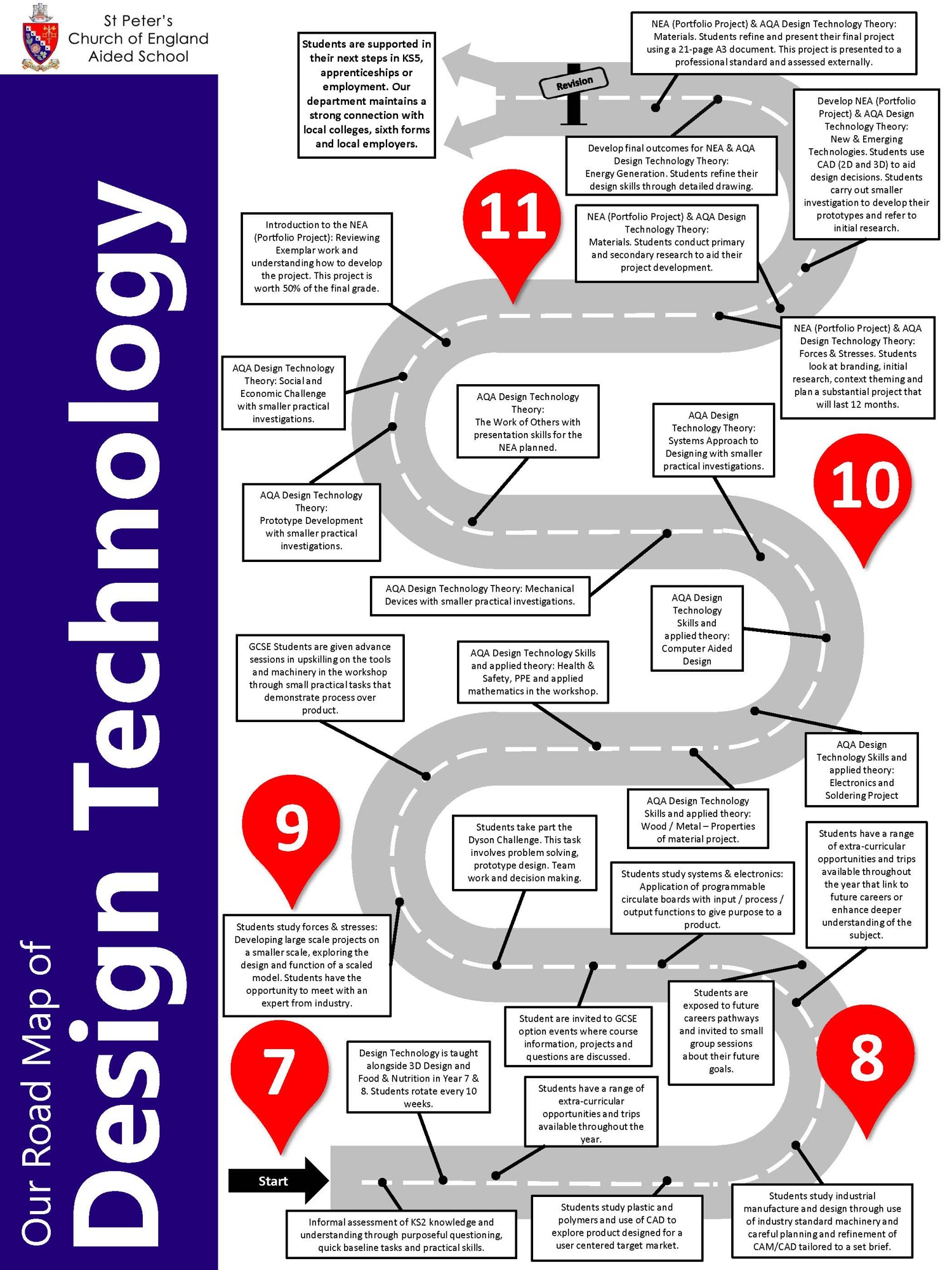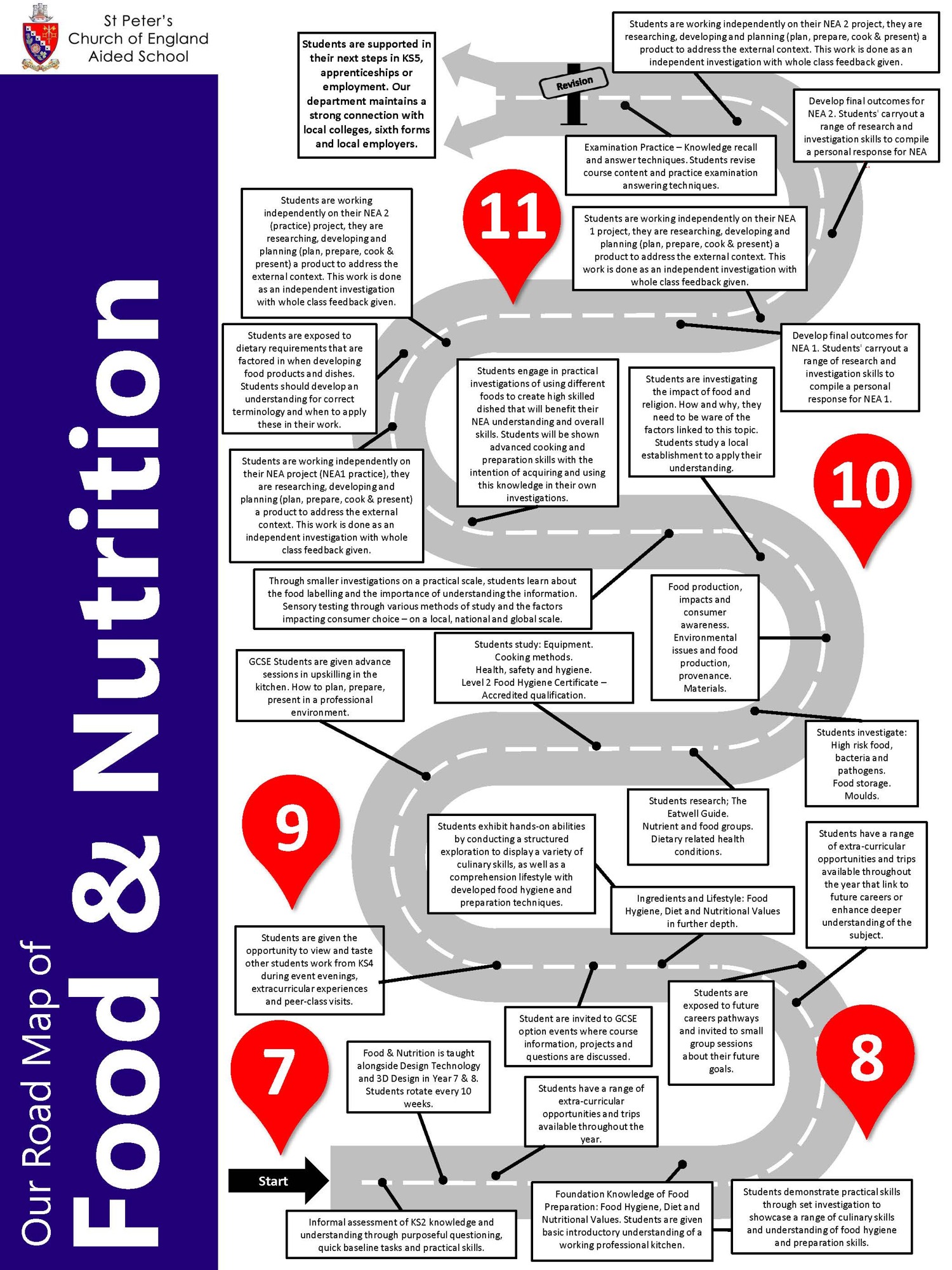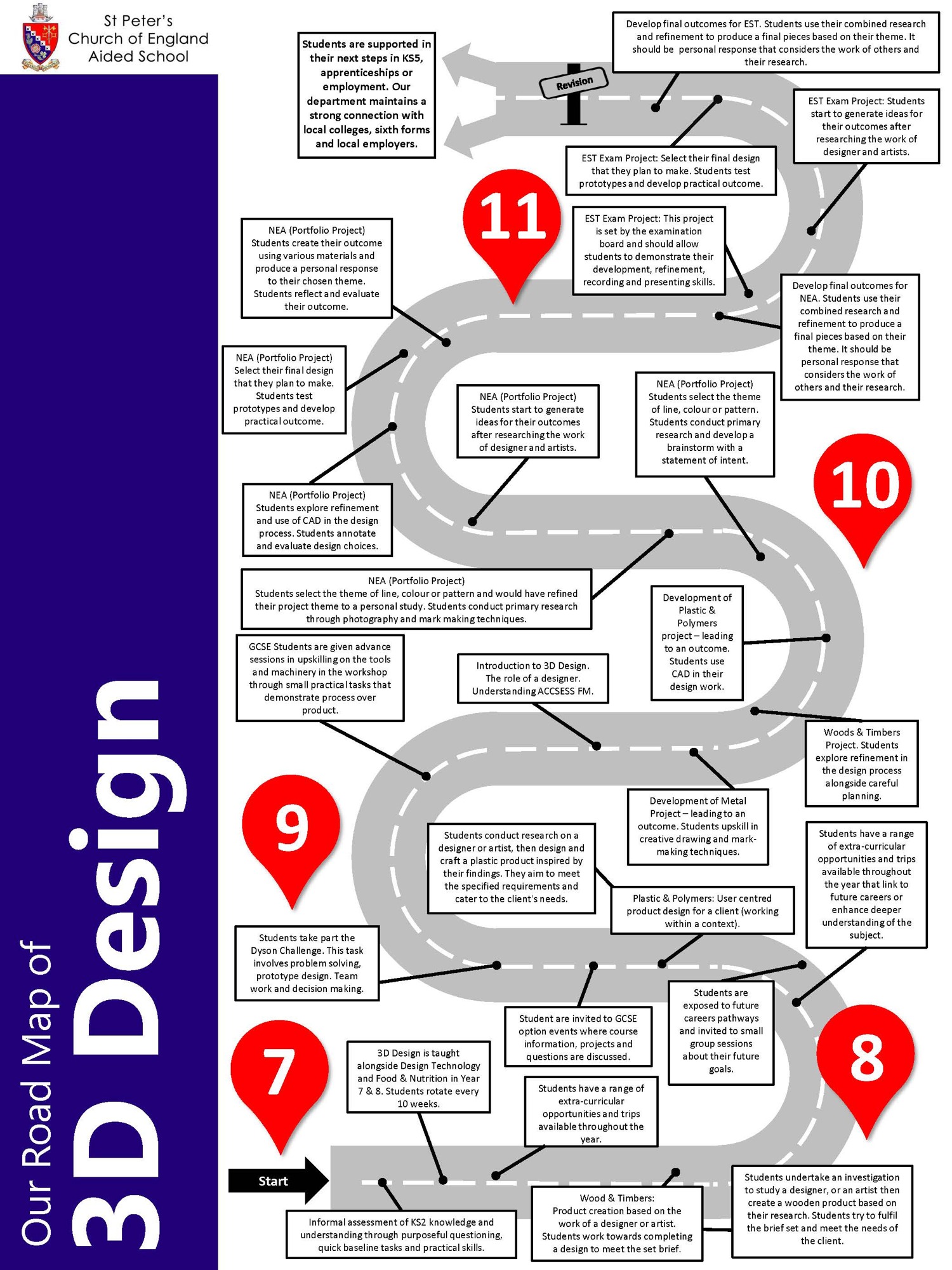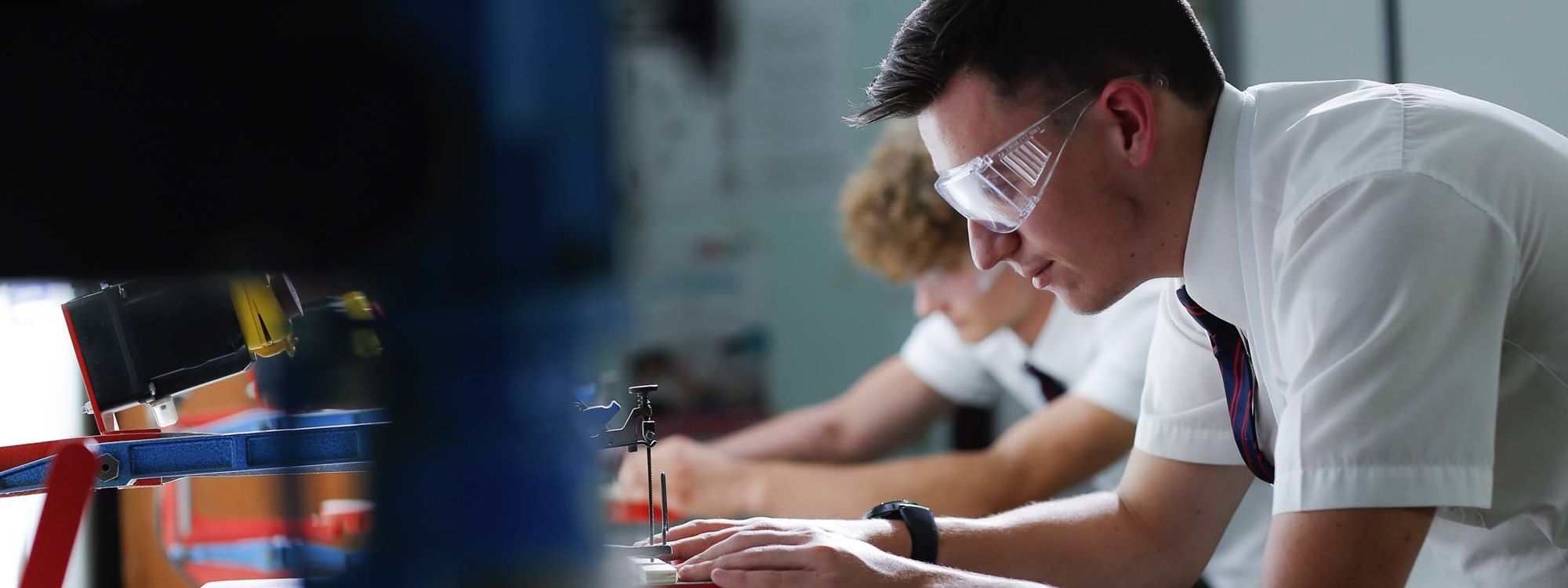Design & Technology
Design and technology is an inspiring, rigorous and practical subject. Using creativity and imagination, pupils design and make products that solve real and relevant problems within a variety of contexts, considering their own and others’ needs, wants and values. They acquire a broad range of subject knowledge and draw on disciplines such as mathematics, science, engineering, computing and art. Pupils learn how to take risks, becoming resourceful, innovative, enterprising and capable citizens. Through the evaluation of past and present design and technology, they develop a critical understanding of its impact on daily life and the wider world. High-quality design and technology education makes an essential contribution to the creativity, culture, wealth and well-being of the nation.
Working in stimulating contexts that provide a range of opportunities and draw on the local ethos, community and wider world, students identify needs and opportunities. They respond with ideas, products and systems, challenging expectations where appropriate. They combine practical and intellectual skills with an understanding of aesthetic, technical, cultural, health, social, emotional, economic, industrial and environmental issues. As they do so, they evaluate present and past design and technology, and its uses and effects. Through design and technology students develop confidence in using practical skills and become discriminating users of products. They apply their creative thinking and learn to innovate.
CURRICULUM AIMS
Learning and undertaking activities in design and technology contribute to achievement of the curriculum aims for all young people to :
- Develop the creative, technical and practical expertise needed to perform everyday tasks confidently and to participate successfully in an increasingly technological world.
- Build and apply a repertoire of knowledge, understanding and skills in order to design and make high-quality prototypes and products for a wide range of users.
- Critique, evaluate and test their ideas and products and the work of others.
- Understand and apply the principles of nutrition and learn how to cook.
YEARS 7 & 8
Students across all technology disciplines are encouraged to increase their research, understanding, designing and practical making skills - possibly in preparation for taking a GCSE subject in this department. To those students who choose not to follow a GCSE in this department, they will still benefit from learning problem solving and practical real life skills. Students are encouraged to develop designing skills, develop and practise new practical skills, explore their creativity, new techniques and technologies and to learn how products are designed and made.
YEAR 9 -11 OPTIONS WITHIN DESIGN TECHNOLOGY
Students option subjects:
- GCSE Design Technology (AQA)
- GCSE 3D Design (AQA)
- GCSE Food & Nutrition (WJEC Eduqas)
GROUPING
At KS3: Students are taught in mixed ability groups on a rotation across the D & T disciplines 3D Design, Systems & Electronics, Food & Nutrition and Product Design.
At KS4: Students are taught in mixed ability groups in specialist rooms with specialist staff.
STAFFING
- Jamie Pearce - Subject Learning Leader for Design & Technology – Teacher of 3D Design, Graphic Design and Design Technology
- Jo Bowden-Williams – Teacher of Food & Nutrition
- Martin Hawker – Teacher of Systems & Electronics / Design Technology
- Mike Evans – Teacher of Product Design / Design Technology
- Toby May – Teacher of Food & Nutrition
- Natalie Corbridge - Technology Workshop Technician
- Bev Warren - Food & Nutrition Technician
- Anastasia Pereverzieva – Food & Nutrition Technician / Let’s Get Cooking Co-ordinator
ENRICHMENT & EXTRA CURRICULAR ACTIVITIES
The rooms are open most lunchtimes for students to develop their skills. They can use the computers and resources to help them to complete homework tasks, and will have opportunities to take part periodically in structured art activities during lunchtimes or after school workshops. The workshops and room rooms are always staffed for health and safety puporses, no students are allowed in these rooms with out supervision.
There is a weekly after school session for GCSE students who need a quiet space to work or additional guidance with their projects.
Homework
Assessment
GCSE Design & Technology (AQA)
GCSE Design and Technology covers a wide range of activities based on designing and making products that are manufactured a wide range of materials. As well as learning hand skills, students will use a range of industrial processes to shape and form materials into functioning products. Over the course of two years students will develop a whole range of creative designing and making skills, technical knowledge and understanding relating to the world of Design and Manufacture and invaluable transferable skills such as problem solving and time management. This area of study focuses on designing and making, using different materials and techniques.
Assessment at the examination stage takes place through a controlled assessment task worth 50% of the overall grade and a written examination also worth 50%. All non-examinable assessment work is internally assessed and externally moderated. We aim to make the subject as close to the real world as we can. Students will have the opportunity to create their own design brief based on the contextual themes set by the examination board in June of each year; this encourages them to work independently and produce exciting and innovative products. As part of the making process, students learn traditional methods of communicating design through hand drawings and 3D prototype models. Students then progress to specialised 2D & 3D ICT design packages to cover CAD/CAM (Computer Aided Design/Computer Aided Manufacture). By the end of the course, students should have a sound knowledge of theory, a coursework folio and practical prototypes that they can be proud of.
The course prepares students to design and make creative products for an end user using a range of materials, such as: wood, metal and plastic, man-made boards, and card. Prototypes and models may be crafted by hand, using manual machines or with CAD/CAM such as the school laser cutter with the aim of producing high-quality outcomes.

FOOD & NUTRITION GCSE (WJEC/EDUQAS)
The WJEC Eduqas GCSE in Food Preparation and Nutrition equips learners with the knowledge, understanding and skills required to cook and apply the principles of food science, nutrition and healthy eating. It encourages learners to cook, enables them to make informed decisions about food and nutrition and allows them to acquire knowledge in order to be able to feed themselves and others affordably and nutritiously, now and later in life.
Students will:
- Work with varied and interesting ingredients to create diverse, well presented and tasty dishes.
- Gain an understanding of the impact of food choices and food production in the wider world: economic, environmental and social/cultural.
- Learn about food function, handling and food safety.
- Develop an understanding of food science & the functional properties of food.
- Gain a greater understanding of nutrition, diet and its relation to good physical and psychological health.
- Develop a range of transferable life skills such as independent working, team work, problem solving and reflecting.
- Strong links with other core subjects e.g. English, Maths & Science, Geography, P.E, Beliefs and values, Citizenship & D&T; building a strong platform for a range of future careers.
There will be one written exam on the Principles of Food Preparation and Nutrition of 1 hour 45 min in length worth 50% of final mark.
There are also 2 controlled assessments which will count towards your final grade, worth 50% of the final mark:
1. Food Preparation
A scientific food investigation which will assess the learner’s knowledge, skills and understanding in relation to scientific principles underlying the preparation and cooking of food.
2. Nutrition in Action
Prepare, cook and present a menu which assesses the learner’s knowledge, skills and understanding in relation to the planning, preparation, cooking and presentation of food.
Students should:
- be prepared to cook and possibly supply food ingredients regularly (every week)
- be able to work hard and enjoy making exciting food dishes whilst finding out useful information to keep them healthy throughout their lives.

GCSE 3D DESIGN (AQA)
- actively engage in the creative process of art, craft and design in order to develop as effective and independent learners, and as critical and reflective thinkers with enquiring minds
- develop creative, imaginative and intuitive capabilities when exploring and making images, artefacts and products
- become confident in taking risks and learn from experience when exploring and experimenting with ideas, processes, media, materials and techniques
- develop critical understanding through investigative, analytical, experimental, practical, technical and expressive skills
- develop and refine ideas and proposals, personal outcomes or solutions with increasing independence
- acquire and develop technical skills through working with a broad range of media, materials, techniques, processes and technologies with purpose and intent
- develop knowledge and understanding of art, craft and design in historical and contemporary contexts, societies and cultures
- develop an awareness of the different roles and individual work practices evident in the production of art, craft and design in the creative and cultural industries • develop an awareness of the purposes, intentions and functions of art, craft and design in a variety of contexts and as appropriate to students’ own work • demonstrate safe working practices in art, craft and design

Core Texts in KS3
Our KS3 Design Technology refers to core texts. These texts are real published work that students may be exposed to when researching in this subject. We want to help students understand design literature and how to analyse and use it. Each DT rotation will refer to the core text as the project develops, often teachers will refer to other core texts that students have been exposed to and use the same skills to understand the text.



